
The Messerschmitt Me 163 Komet is a rocket-powered interceptor aircraft primarily designed and produced by the German aircraft manufacturer Messerschmitt. It is the only operational rocket-powered fighter aircraft in history as well as the first piloted aircraft of any type to exceed 1,000 kilometres per hour (620 mph) in level flight.

Saab AB is a Swedish aerospace and defence company, founded in 1937. Headquartered in Stockholm, the development and the manufacturing is undertaken in Linköping. Saab produced automobiles from 1947 until 1990 when the automobile division was spun off as Saab Automobile, a joint venture with General Motors. The joint venture ended in 2000 when GM took complete ownership. From 1968 onwards the company was in a merger with commercial vehicle manufacturer Scania-Vabis, known as Saab-Scania. The two were de-merged in 1995 by the new owners, Investor AB. Despite the demerger, both Saab and Scania share the right to use the griffin logo, which originates from the coat of arms of the Swedish region of Scania.

The Saab 37 Viggen is a retired Swedish single-seat, single-engine, short-medium range multirole combat aircraft. Development work on the type was initiated at Saab in 1952 and, following the selection of a radical delta wing configuration, the resulting aircraft performed its first flight on 8 February 1967 and entered service in 21 June 1971. It was the first canard design produced in quantity. The Viggen was also the most advanced fighter jet in Europe, albeit slower than the earlier MiG-21bis, until the introduction of the Panavia Tornado into operational service in 1981.

A delta wing is a wing shaped in the form of a triangle. It is named for its similarity in shape to the Greek uppercase letter delta (Δ).
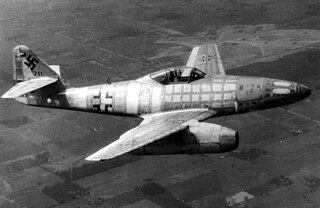
A swept wing is a wing that angles either backward or occasionally forward from its root rather than in a straight sideways direction.
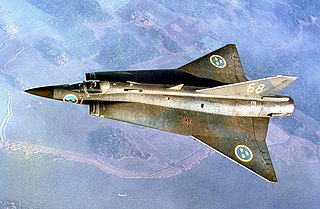
The Saab 35 Draken ) is a Swedish fighter-interceptor developed and manufactured by Svenska Aeroplan Aktiebolaget (SAAB) between 1955 and 1974. Development of the Saab 35 Draken started in 1948 as the Swedish air force future replacement for the then also in development Saab 29 Tunnan dayfighter and Saab 32B Lansen night fighter. It featured an innovative but unproven double delta wing, which led to the creation of a sub-scale test aircraft, the Saab 210, which was produced and flown to test this previously-unexplored aerodynamic feature. The full-scale production version entered service with frontline squadrons of the Swedish Air Force on 8 March 1960. It received the designation Flygplan 35 and was produced in several variants and types, most commonly as a fighter type with the prefix J, standing for Jaktflygplan (Pursuit-aircraft), the Swedish term for fighter aircraft.
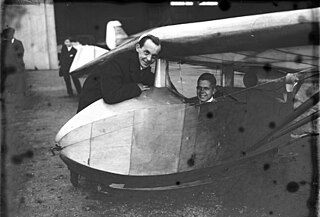
Alexander Martin Lippisch was a German aeronautical engineer, a pioneer of aerodynamics who made important contributions to the understanding of tailless aircraft, delta wings and the ground effect, and also worked in the U.S. Within the Opel-RAK program, he was the designer of the world's first rocket-powered glider.
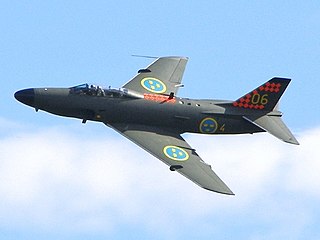
The Saab 32 Lansen is a two-seat, transonic military aircraft designed and manufactured by Saab AB from 1955 to 1960 for the Swedish Air Force (Flygvapnet). Three principal variants of the Lansen were built for attack, fighter, and reconnaissance. During its long operational life, the Saab 32 also served in the electronic warfare role and as a target-tug.

The Saab 29 Tunnan, colloquially Flygande tunnan or just Tunnan, is a Swedish fighter that was designed and manufactured by Saab in the late 1940s. It was the second turbojet-powered combat aircraft to be developed in Sweden, the first being the Saab 21R, and it was the first Western European fighter to be produced with a swept wing post World War II, only being preceded in Western Europe as a whole by the Me 262 built during the war. Despite its rotund appearance, from which its name is derived, the J 29 was fast and agile and served effectively in both fighter and fighter-bomber roles into the 1970s.
Aarne Lakomaa (1914–2001) was a Finnish aircraft designer. Born in Finland, Lakomaa graduated from Helsinki Polytechnics. He fought as an Army Lieutenant in the Winter War (1939–40) and the Continuation War (1941–44) against the Soviet Union. There he became famous for fitting captured Russian engines to the obsolete French fighter Morane-Saulnier M.S.406, thereby creating a first rate fighter, the Mörkö-Morane. Aarne Lakomaa first replaced the original Hispano-Suiza 12Y 31 liquid-cooled V-12 rated at 860 hp with a 1,100 hp Soviet engine— the Klimov M-105P—which was a war booty. This engine was installed under the cover of a more aerodynamic cowling and fitted with a different pitch propeller. The French M.S.406's airframe was strengthened, and an oil cooler from a Messerschmitt-109 replaced the old one. In this way over-heating problems was finally solved. As a result of these modifications, the improved version of Morane had a 36-mph speed advantage over all previous versions.

The Lippisch P.12, P.13a and P.13b were related design projects for a ramjet-powered delta wing interceptor aircraft studied in 1944 by German designer Alexander Lippisch. The P.12 and P.13a were unarmed, relying on reinforced wings to ram its opponent. The P.13a and b were to be powered by powdered coal. The DM-1 was a full-size glider, flown to test the P.12/13a low-speed aerodynamics. The design series were unrelated to the earlier P.13 produced by Messerschmitt's Lippisch design office.
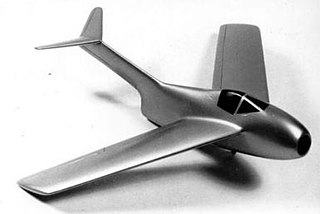
The Focke-Wulf Ta 183 Huckebein was a design for a jet-powered fighter aircraft intended as the successor to the Messerschmitt Me 262 and other day fighters in Luftwaffe service during World War II. It had been developed only to the extent of wind tunnel models when the war ended, but the basic design was further developed postwar in Argentina as the FMA IAe 33 Pulqui II. The name Huckebein is a reference to a trouble-making raven from an illustrated story in 1867 by Wilhelm Busch.
This is a list of weapons used by the Swedish Air Force.

Swedish Air Force Historic Flight is an association that flies former Swedish Air Force aircraft and maintains them in an airworthy condition. SwAFHF has been active since 1998 and is housed in premises of the Skaraborg Wing. SwAFHF is authorized by the Swedish Civil Aviation Administration and the aircraft have civilian Swedish aircraft registration.
Drivecenter Arena, previously known as Skellefteå Drive Center, is a motorsport race track in Fällfors, Sweden. The circuit opened in 2019 having been converted from a retired Swedish Air Force base, Fällfors Air Base.

Bertil Dillner was a Swedish aeronautical engineer and aerodynamic expert. He was significant in the development of delta wing aerodynamics and supersonic flight concepts. Dillner served for many years as manager of Boeing engineering design offices.

Erik Gustaf Bratt was a Swedish engineer and pilot. Erik Bratt was the brother of Colonel Lars Bratt.
Tore Ragnar Gullstrand, born 16 August 1921 in Karlstad, died 2002 in Linköping, was a Swedish business leader in the aviation industry and researcher in aeronautics. He was the son of Ragnar Gullstrand.
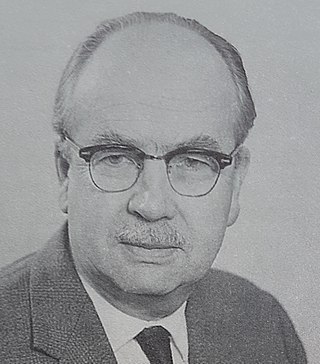
Frid Benjamin Filippus Wänström was a Swedish aviation engineer who after KTH Royal Institute of Technology in 1932 was employed by the flygstyrelsen, from 1936 head of the calculation department Saab AB in Linköping.

















